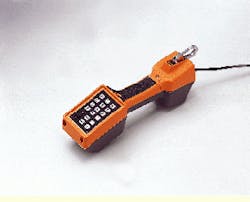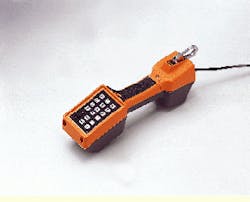Gail Leach Carvelli
Technicians rely on one of the most commonly used pieces of telecommunications test equipment to detect noise, transmission loss or opens and shorts--the butt set. Resembling an ordinary telephone handset, this versatile tool often contains high-tech features that make it easier to identify and monitor a wide range of voice-line problems.
Introduced in the 1920s and 1930s, butt sets have evolved into a tool that nearly every technician carries. Not only do they let technicians test line functionality, but they also allow contact with the central office to execute diagnostic tests or generate a call to speak with people inside or outside the building (see Product Update table beginning on page 18).
Compliance with Bellcore specs
Butt sets contain many standard features, such as the ability to switch between tone and pulse operations; in addition, they should all comply with tr-tsy-000344, generic requirements for the craftsperson`s handset. Issued by Bell Communications Research (Bellcore--Livingston, NJ), this standard covers applications for originating test calls on dual-tone, multiple-frequency, and dial-pulse telephones, and for testing the switching, continuity, and talking features of the line circuit.
"This is really the only specification ever written for these tools," says Bruce Bond, branch manager for Chesivale Electronics Ltd. "So when buyers are looking for this type of tool, they want assurance that it is a quality instrument. The question should always be if the tool meets Bellcore specifications."
Ruggedness paramount
An important component of the Bellcore specification is its emphasis on ruggedness and the tool`s ability to withstand varying environmental conditions.
"Durability is always a substantial issue," says Dave Adams, an installer for Vista Computer Services (Chantilly, VA). "Sometimes you`re working in a nasty environment, such as in air-conditioning vents, and are weighed down with a number of other tools on your belt. As you go through a tight doorway, your tools tend to jam into the walls. So for me, durability attributes are more important than the electrical ones. I want a tool that is rugged."
Most manufacturers satisfy that need by constructing tools that are suitable for indoor and outdoor applications. Some encase the tool in a strong plastic shell; one manufacturer uses a rubber housing to protect the sophisticated equipment inside.
"Technicians are tough on their tools and we understand that," says Jack Bohnsack, president of beco Manufacturing Corp. "So we make our tools out of a rubber compound that allows them to withstand a 40-foot fall."
The tool must also be able to withstand harsh environmental conditions such as rain, notes Chesivale`s Bond. "Resistance to moisture is vital because repairmen are often out during heavy rain," he adds. "The tool must work consistently, even if dropped in a flooded manhole."
Keeping lines safe
Manufacturers also make butt sets that prevent a technician from mistaking a digital circuit for a voice one, which is easy to do, according to Bond. "Now, you hear nothing when you put your butt set across a digital line. The line is absolutely silent," he notes.
Typically, if a technician unknowingly clips onto a digital line and switches to talk mode, he or she risks interrupting data flow and dumping the data, according to Michael Gayaldo, marketing manager for the Harris Corp. "A few of today`s test sets sense the high-speed data and will do one of two things," he says. "They will stop the test set from going off hook and drawing current, and some will send an audible alert to the technician."
Making the tool convenient
Because these tools are used frequently, most installers require that they be convenient and efficient, with features such as large belt clips, polarity indicators, pause buttons, last-number redial, and memory store and recall. Perhaps two of the most handy characteristics are an amplified speaker and a two-way speakerphone.
"People out in the field get placed on hold often, and without this option, they have to hold the phone while they are waiting," says Gayaldo. "An amplified speakerphone allows technicians to continue working while waiting for a response. They can put down the phone and return to it when the caller returns."
A two-way speakerphone lets a technician hang the test set from a cable or rack and work with both hands while he is talking with a craftsperson at the other end of the line. Unlike the amplified speaker mode, which only allows messages to pass in one direction, a two-way speakerphone allows information to pass in both directions.
More features equals higher price
While such features make for a handier test set, they also add to the overall cost. Generally, those technicians working indoors or in a premises environment will usually find all that they need in the less expensive models: those technicians working in central-office or outside-plant applications need the more sophisticated models. Test sets can range in price from less than $100 to $500 for traditional test sets, to nearly $3000 for those compatible with Integrated Services Digital Network lines.
"Those extra features are certainly beneficial, but they are also much more expensive," notes Daniel Glover, a field engineer with Future Design Communications of the Southeast (Norcross, GA). "What it comes down to--for me, anyway--is getting a butt set that I can afford. That may mean getting one that doesn`t have all the extras."
Resembling an ordinary telephone handset, the Harris Corp.`s TS22AL butt set offers data protection and a speakerphone, as well as other common features.
A Tool of Many Names
The purpose of a butt set may be simple--verifying a voice line`s functionality. But deciding what to call the tool is more difficult.
"There really are several different names out there for this type of tool," says Michael Gayaldo, marketing manager for the Harris Corp. "One of the most common names out in the field is the butt set."
Second to butt set is the term butt-in test set, which in the most literal sense refers to the tool`s objective. "Basically, it means that it is the thing that you `butt in` on a telephone line with," says Bruce Bond, branch manager of Chesivale Electronics Ltd. (Sedona, AZ).
While butt set and butt-in test set or butt-in set are the most common terms, other names include test telephone, lineman`s test set, craftsperson`s handset and buttinski.
For More Information...
"Butt-in test sets--basic equipment for a thriving market," December 1995, page 6.


